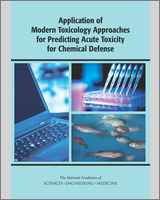NCBI Bookshelf. A service of the National Library of Medicine, National Institutes of Health.
Committee on Predictive-Toxicology Approaches for Military Assessments of Acute Exposures; Committee on Toxicology; Board on Environmental Studies and Toxicology; Board on Life Sciences; Division on Earth and Life Studies; The National Academies of Sciences, Engineering, and Medicine. Application of Modern Toxicology Approaches for Predicting Acute Toxicity for Chemical Defense. Washington (DC): National Academies Press (US); 2015 Sep 1.

Application of Modern Toxicology Approaches for Predicting Acute Toxicity for Chemical Defense.
Show detailsThe National Academy of Sciences was established in 1863 by an Act of Congress, signed by President Lincoln, as a private, nongovernmental institution to advise the nation on issues related to science and technology. Members are elected by their peers for outstanding contributions to research. Dr. Ralph J. Cicerone is president.
The National Academy of Engineering was established in 1964 under the charter of the National Academy of Sciences to bring the practices of engineering to advising the nation. Members are elected by their peers for extraordinary contributions to engineering. Dr. C. D. Mote, Jr., is president.
The National Academy of Medicine (formerly the Institute of Medicine) was established in 1970 under the charter of the National Academy of Sciences to advise the nation on medical and health issues. Members are elected by their peers for distinguished contributions to medicine and health. Dr. Victor J. Dzau is president.
The three Academies work together as the National Academies of Sciences, Engineering, and Medicine to provide independent, objective analysis and advice to the nation and conduct other activities to solve complex problems and inform public policy decisions. The Academies also encourage education and research, recognize outstanding contributions to knowledge, and increase public understanding in matters of science, engineering, and medicine.
Learn more about the National Academies of Sciences, Engineering, and Medicine at www.nationalacademies.org.
- The National Academies of Sciences, Engineering, and Medicine - Application of M...The National Academies of Sciences, Engineering, and Medicine - Application of Modern Toxicology Approaches for Predicting Acute Toxicity for Chemical Defense
- mitochondrial 54S ribosomal protein YmL9 [Saccharomyces cerevisiae S288C]mitochondrial 54S ribosomal protein YmL9 [Saccharomyces cerevisiae S288C]gi|6321659|ref|NP_011736.1|Protein
- Mus musculus Atp6c2 mRNA for proton-translocating ATPase C subunit isoform C2, c...Mus musculus Atp6c2 mRNA for proton-translocating ATPase C subunit isoform C2, complete cdsgi|28804481|dbj|AB088357.1|Nucleotide
- mitochondrial PDHA1 [Homo sapiens]mitochondrial PDHA1 [Homo sapiens]gi|148357460|gb|ABQ59099.1|Protein
- PREDICTED: Mus musculus zinc finger protein 385A (Zfp385a), transcript variant X...PREDICTED: Mus musculus zinc finger protein 385A (Zfp385a), transcript variant X7, mRNAgi|1907113029|ref|XM_006521055.5|Nucleotide
Your browsing activity is empty.
Activity recording is turned off.
See more...